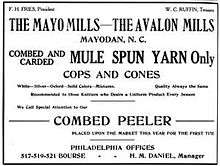Avalon, North Carolina

Avalon was a town in Rockingham County, North Carolina, in the United States. It was centered around a textiles mill constructed by Francis Henry Fries at the end of the 19th century. In 1911 the mill burnt down. Most the population moved their homes to Mayodan, North Carolina and the area was left abandoned.
History
Establishment

In 1887, Francis Henry Fries, a prominent businessman from Winston-Salem, constructed the Roanoke and Southern Railway, which stretched from his home town to Roanoke, Virginia. Seeking to develop industry along the rail line, Fries erected the Mayo Mill adjacent to the Mayo River in 1895 and established the town of Mayodan.[1] The Mayo Mill could not keep up with demand for yarn, so from 1899–1900 a new mill was built two miles to the north, taking the name Avalon, after Avalon, California.[2] Construction was undertaken by S. S. Ordway & Sons, an independent contractor.[3] At the time the four-story building was the largest textile mill in North Carolina. The south wall of the main building was made of wooden planks so it could be dismantled to allow for expansions and renovations.[4]
A village arose around the mill, taking its name. It was home to over 450 people, of whom over half worked in the mill.[5] Some residents immigrated from as far as Durham and Raleigh to find employment in Avalon. A few African-Americans also lived at the outskirts of the village and worked in the mill's dye house.[6] In addition to the mill, the town consisted of a dam and artificial canal, 60 company houses, a boarding house, a hotel, a store, and a Moravian Church. Electricity came from a water-powered generator at the mill.[2] No formal government was ever established in Avalon, so most events were either centered around the church or the mill.[7] On November 23, 1908 a fire destroyed the company store, causing an estimated $20,000 in damage.[8]
Mill fire and aftermath
Just before 6:00 PM on June 15, 1911 a machine on the fourth floor overheated, starting a fire.[2] The mill had a modern fire sprinkler system, but the water pumps failed and the entire complex burnt down.[9] Though it was fully insured, Fries decided not to rebuild and instead reinvested in the Mayo Mill, transferring his employees and resources there.[2] All 60 of the company houses were put on logs and rolled by mules and horses to Mayodan.[10] The church was dismantled and its lumber was used for construction in Mayodan.[7] In 1916, Fries briefly returned to the site of the mill to dismantle the dyeing equipment for use in the Mayo Mill.[11]
The remains of Avalon are situated about a mile from U.S. Route 220 on private property.[12]
Citations
- ↑ Connor, Boyd & Hamilton 1919, p. 3
- 1 2 3 4 Battaglia 2015
- ↑ Edwards & Broughton 1912, p. 100
- ↑ Aheron 1997, p. 13
- ↑ Graham 2011
- ↑ Dillon 1974, p. 15
- 1 2 Aheron 1997, p. 14
- ↑ The Union Republican 1908, p. 7
- ↑ Mayodan Diamond Jubilee Committee 1974, p. 2
- ↑ Aheron 1997, p. 26
- ↑ Causey & Smith 2004, p. 12
- ↑ Aheron 1997, p. 12
References
- Aheron, Piper (1997). From Avalon to Eden: A Postcard Tour of Rockingham County. Images of America (illustrated ed.). Arcadia Publishing. ISBN 9780752408248.
- Battaglia, Danielle (14 June 2015). "THE DEATH OF A TOWN: Avalon". Greensboro News & Record. Retrieved 13 May 2016.
- Causey, Evelyn D.; Smith, Kathryn Gettings (December 2004). "Washington Mills-Mayodan Plant" (pdf). National Register of Historic Places - Nomination and Inventory. North Carolina State Historic Preservation Office. Retrieved 2015-02-01.
- Connor, R. D. W.; Boyd, William Kenneth; Hamilton, Joseph Grégoire de Roulhac (1919). History of North Carolina. 5 (illustrated ed.). Chicago and New York City: Lewis Publishing Co. pp. 2–4.
- Dillon, Vera W. (1974). Avalon: A Brief History of a Fateful Town. Madison. OCLC 988273995.
- "Fire at Avalon". The Union Republican. Winston-Salem. November 26, 1908.
- Graham, Nick (16 September 2011). "The Avalon Mill Fire". Digital North Carolina Blog. North Carolina Digital Heritage Center. Retrieved 12 November 2016.
- North Carolina Reports: Cases Argued and Determined in the Supreme Court of North Carolina. North Carolina reports. 157. Edwards & Broughton. 1912.
- Mayodan, North Carolina: "75 Going on 200," 1899-1974. Mayodan, North Carolina: Mayodan Diamond Jubilee Committee. 1974.
